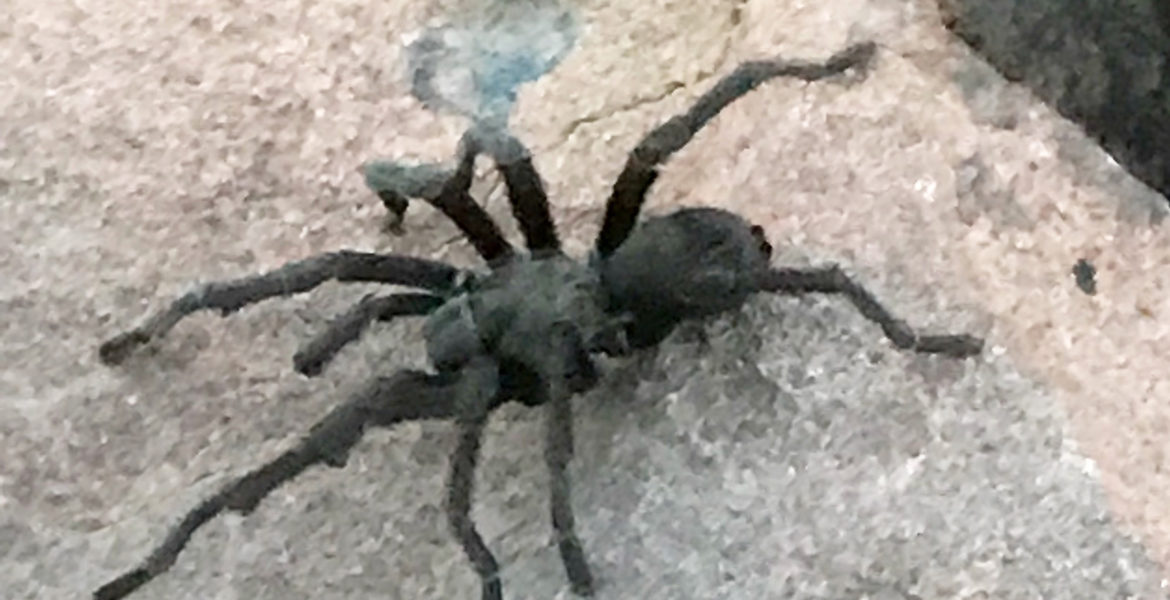Giant spiders lurk in dark places…in J.R.R. Tolkien’s Middle Earth and in J.K. Rowling’s Harry Potter books, but one doesn’t need magic or the imagination of British authors to conjure enormous arachnids in the Santa Monica Mountains. They live here.
Throughout late summer and autumn, tarantulas begin to appear. Topanga drivers occasionally have to stop for spider crossings. The big arachnids turn up on hiking trails, driveways, doorsteps, and even in pool filters.
Female tarantulas spend their lives underground and are rarely seen, but male tarantulas, responding to biological need, leave the safety of their burrows to find a mate once they mature.
National Park Service volunteer Abby Pina describes this migration, not as an invasion but as a love story.
Pina recently led a “tarantula walk” for more than 70 enthusiastic spider seekers at Rancho Sierra Vista at the western end of the Santa Monica Mountains National Recreation Area. She described how the female tarantula weaves a special web containing pheromones to attract a mate to her burrow, and how the males often travel great distances to find a female.
Male tarantulas face numerous perils during migration: cars, predators, illegal collectors looking for specimens to sell for the pet trade, and the species’ main predator, the tarantula wasp, which subdues the spider with a powerful sting and lays its eggs on the involuntary host.
Tarantulas have poor vision and no ears, but they are highly sensitive to vibrations and are thought to navigate and hunt using this special spider sense. Males are sometimes spotted performing a “dance,” drumming on the ground above the female’s burrow to entice her out.
The very thing that drives the spiders to leave the safety of their burrows can be the most dangerous aspect of the journey but, said Pina, “If the female is hungry, she may eat the male.”
Pina’s hiking group didn’t see a tarantula in the wild, but a couple of pet specimens were on hand at the end of the walk to give participants a chance to see the spiders up close.
Topanga resident Nancy Nelms-Girmant didn’t need to take a guided hike to meet a tarantula. She recently found one on her doorstep.
“My friend rescued a fluffy black kitten and this fluffy black guy showed up on my doorstep,” she posted on Instagram. “I won’t be adopting him.”
Pina recommends leaving the big spiders alone. If one turns up in the house, the best approach is to put a waste basket or large container over it and gently slip a piece of paper under the spider, then relocate it outside.
The tarantulas that are native to the Santa Monica Mountains are not aggressive, but they can reportedly deliver a painful bite if frightened, and the fine hairs that give the tarantula its distinctive furry look can break off and cause skin irritation if the spiders are handled.
Tarantulas are long-lived. Males mature at around seven to eight years of age, although they rarely survive their mating migration. Female tarantulas can live to be 25, and there are accounts of captive California tarantulas surviving to 40.
Arachnophobes may not be enthused about the annual tarantula migration, but unlike their literary counterparts, these spiders are good neighbors, eating pest species like scorpions, beetles, grasshoppers, other spiders, and occasionally even mice.
The annual tarantula migration usually peaks in September but continues through October. Canyon residents can help by slowing down and watching for tarantulas on the road and trail, and by avoiding toxic pesticides in the garden and around the house.

